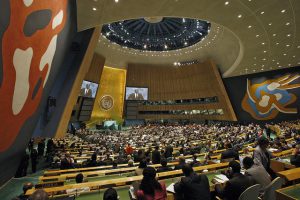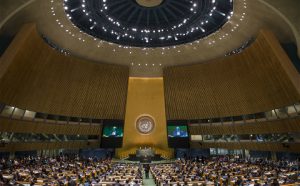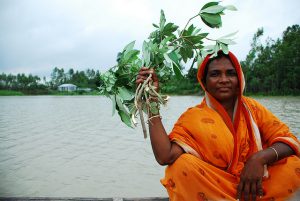China, along with the other BRICS, has ramped up its investment in developing countries. What will this mean for its model of aid and development?
In July, the five BRICS – Brazil, Russia, India, China and South Africa – came together at their annual summit to announce the establishment of a new, hotly anticipated BRICS development bank, a multilateral initiative led entirely led by Southern countries and widely seen as a competitor to the Western dominated World Bank and IMF.
With start-up capital of US$1 billion, funded equally from the five partners, the New Development Bank is to focus on addressing the infrastructure funding deficit in the developing world, as well as a Contingency Reserve Arrangement (CRA), which would provide emergency liquidity for Southern governments for future financial crises.
The bank’s establishment reflects the growing role – and financial clout – of the BRICS in development finance and development cooperation, and its headquarters in Shanghai demonstrates the weight of China in particular. Having sustained a 30-year economic boom and amassed a war-chest of capital from its trade surplus, China, along with the other BRICS, is increasingly seeking avenues for investment in the developing world.
Part of this is driven by the pragmatic need for oil, minerals and fuel to sustain domestic economic growth; however China’s growing role in Africa, Asia and Latin America is also part of a “Going Out” strategy to expand and internationalise Chinese multinational firms and State-Owned Enterprises (SOEs).
China’s engagement with the African continent has intensified in the last 10 years. This salient geopolitical and economic relationship is politically embedded through the triennial FOCAC (Forum for China-Africa Cooperation) high-level meetings between Chinese and African heads of state, and backed by billions in investment, infrastructure, trade volumes, and development aid. Mass migration of workers has led to a rising Chinese population on the continent, while development of new Chinese media platforms, including a CCTV Africa channel and Chinese radio channels in Kenya and other parts of East Africa, point to a growing cultural presence.
A new White Paper on Foreign Aid released by the Chinese government earlier in 2014 shows that China now channels over 50% of its aid to Africa. China has provided nearly 90 billion yuan in foreign assistance to African countries, consisting largely of interest-free loans, concessional loans, and debt relief to high-indebted poor countries (HIPC), as well as preferential tariff agreements and some grants.
In contrast to the principles of the traditional, developed-country aid model, China does not claim altruistic principles in its development cooperation projects. Rather, along with Brazil, India and South Africa, China frames its aid under a tradition of ‘South-South Cooperation’ dating back to the 1950s, which emphasises technical cooperation and knowledge transfer over financial aid, and principles of mutual benefit and reciprocity over altruism.
Grants, projects and loans are usually one branch of a package of investments which sees benefits for China, usually in the form of natural resources, exchanged for extractive equipment, public infrastructure such as roads, government buildings and hospitals, or other projects. Much of the funding for such projects is also tied to Chinese contractors, benefitting China’s own enterprises and multinationals. Despite the tied nature of Chinese aid, which contravenes OECD principles, the rhetoric of ‘win-win’ has gained China some credibility as a development partner, that offers aid on a more politically equal platform that the Western donor-recipient model of relationship.
China’s economic engagement has boosted growth and economic confidence in much of Africa. Hard investment in roads, railways and state buildings have helped to attract foreign investment from Chinese sources and elsewhere, and the resource-for-equity model that China has adopted in resource-rich states such as Angola and Nigeria have allowed countries to access previously unexploitable mineral resources and export to their advantage.
More subtly, China’s presence has altered the dynamics between developing countries and Western donors. The presence of alternative investors has shifted the balance of power for developing nations negotiating with the West, as well as pushing Africa up Western priority lists. Obama’s recent US-Africa leaders’ summit in August 2014, which follows the model of China’s high-level FOCAC forums, is an explicit demonstration of a new US regard for Africa.
However, China’s aid and investment activities have been politically controversial. Its forays into African natural resources have been criticised for their lack of transparency and consultation in the planning process and environmental impact assessment. This is particularly the case in the oil and minerals sector, as well hydropower, where China has been involved in the construction of key dams in Sudan, Ethiopia and other regions across Africa.
Labour standards and labour disputes in Chinese-run firms have also proved controversial in countries such as Zambia. And illegal logging and poaching, driven by Chinese consumer demands, have also damaged China’s image in Africa.
Such controversies have had an impact back home: China is increasingly conscious of its public image in Africa, and keen to build up its soft power. Many Chinese SOEs now face tougher labour and environmental regulations overseas than they do at home. However, the diversity and sheer number of Chinese actors abroad, from individual entrepreneurs to multinationals, makes control and enforcement of such regulations a struggle.
Non-conditionality and non-interference, as foundational principles in China’s foreign aid and foreign policy, have been particularly controversial, and may be increasingly unsustainable, especially for Africa’s most fragile states. The Sudanese crisis in 2007 tested China’s commitment to non-interference, and created a public relations backlash for a principle previously touted as benign. China’s long-term investments in the continent give it a vested interest in ensuring effective, stable states. This means it will need to care about issues of governance and state-society relations in the countries in which it operates. Moreover, domestic low-carbon innovation and investment give it the opportunity and resources to shape Africa’s sustainable development.
The growing presence of China and other rising powers in development has been a political boon for the leverage and power of developing countries. But as these rising powers become ever stronger economically, the credibility of the South-South Cooperation model is strained, and non-interference increasingly unfeasible. As China’s aid and development programmes grow, some convergence with the Western development model may be unavoidable.




